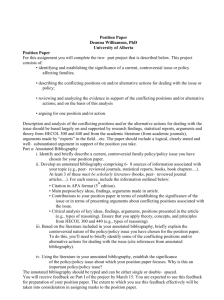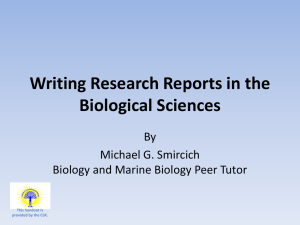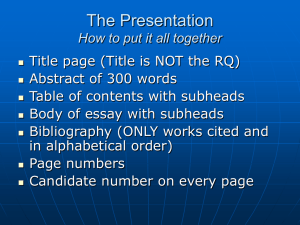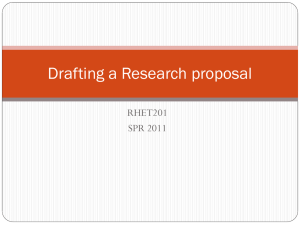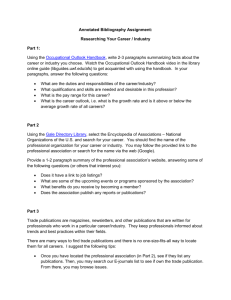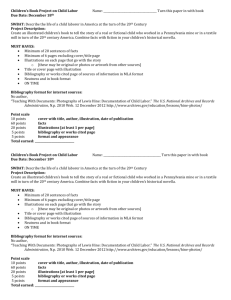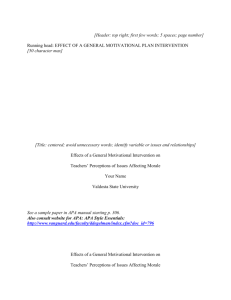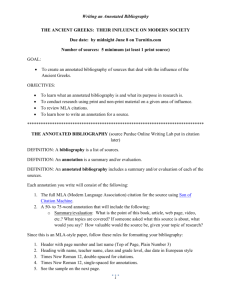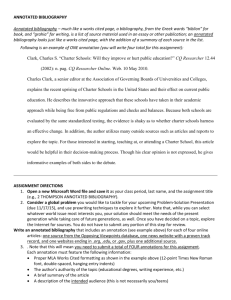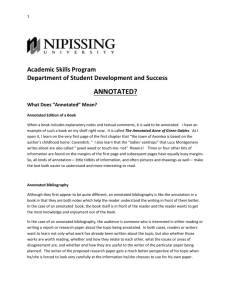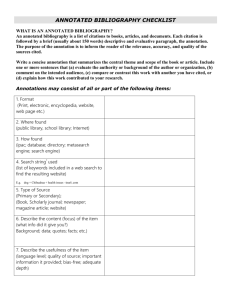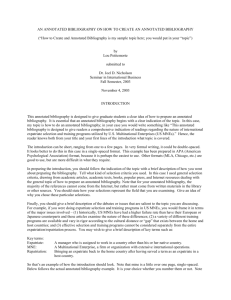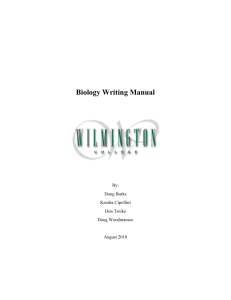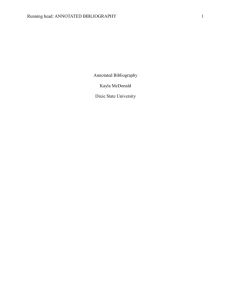Revolutionary War Project
advertisement
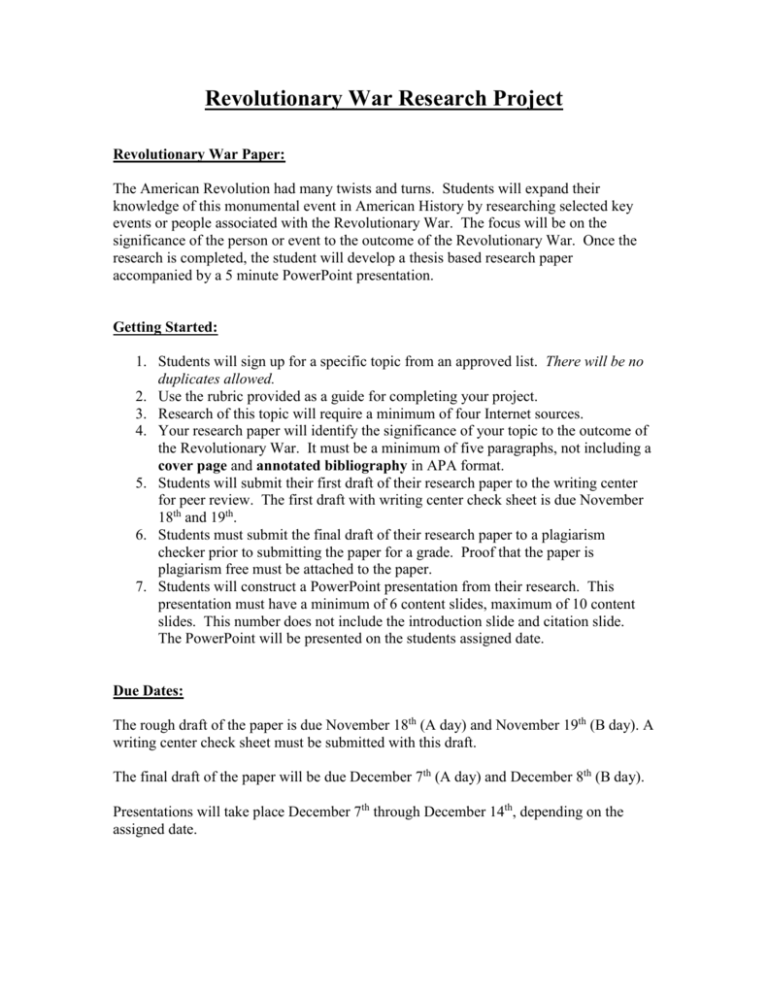
Revolutionary War Research Project Revolutionary War Paper: The American Revolution had many twists and turns. Students will expand their knowledge of this monumental event in American History by researching selected key events or people associated with the Revolutionary War. The focus will be on the significance of the person or event to the outcome of the Revolutionary War. Once the research is completed, the student will develop a thesis based research paper accompanied by a 5 minute PowerPoint presentation. Getting Started: 1. Students will sign up for a specific topic from an approved list. There will be no duplicates allowed. 2. Use the rubric provided as a guide for completing your project. 3. Research of this topic will require a minimum of four Internet sources. 4. Your research paper will identify the significance of your topic to the outcome of the Revolutionary War. It must be a minimum of five paragraphs, not including a cover page and annotated bibliography in APA format. 5. Students will submit their first draft of their research paper to the writing center for peer review. The first draft with writing center check sheet is due November 18th and 19th. 6. Students must submit the final draft of their research paper to a plagiarism checker prior to submitting the paper for a grade. Proof that the paper is plagiarism free must be attached to the paper. 7. Students will construct a PowerPoint presentation from their research. This presentation must have a minimum of 6 content slides, maximum of 10 content slides. This number does not include the introduction slide and citation slide. The PowerPoint will be presented on the students assigned date. Due Dates: The rough draft of the paper is due November 18th (A day) and November 19th (B day). A writing center check sheet must be submitted with this draft. The final draft of the paper will be due December 7th (A day) and December 8th (B day). Presentations will take place December 7th through December 14th, depending on the assigned date. Paper Check-List: 1. ___________ The research paper has an APA cover page. 2. ___________ The research paper is double-spaced, Times New Roman 12 pt. font. 3. ___________ The research paper has 1-inch margins all around. 4. ___________ The research paper is in paragraph format and the start of each paragraph is indented. 5. ___________ The research paper is in APA format with in-text citations. 6. ___________ Any thought or concept presented that is not common knowledge has been cited. 7. ____________ All citations in text correspond to a work cited on the bibliography page. 8. ____________ Any source listed on my bibliography has at least one corresponding in text citation. 9. ____________ There are a total of four sources in my annotated bibliography. 10. ____________ The content of the paper is a minimum of five paragraphs. 11. ____________ A self-evaluated rubric. 12. ____________ Plagiarism check shows a score of 80% or more original work. Revolutionary War Project: Rubric Name: ________________________ Organization Content Quality Sources Mechanics Revolution Topic: _________________________ Exceptional A Very organized with 5 well-constructed paragraphs. Meets required length. Satisfactory B-C 5 paragraphs are organized, but not constructed well. Does not meet required length. Needs Improvement D or lower The information is disorganized and poorly constructed. Paper is too short. Required criteria from the assignment sheet are met thoroughly. Most of the required criteria from the assignment sheet are met. Criteria from the assignment sheet are not met at all. Paper identifies the significance of the topic to the outcome of the Revolutionary War. Summary of topic. Followed most directions / did not go above and beyond. At least 4 reliable sources are used and all are accurately documented in APA format. Excellent annotated bib. There are minimal grammatical or spelling errors. Fewer than 4 reliable sources are used, or sources are not accurately documented in APA format. Good attempt on annotated bib. There are a few errors that make reading difficult. Score Student / Teacher (S)_____/20 (T)_____/20 (S)_____/20 (T)_____/20 Directions were not followed. Appears thrown together with little thought involved. (S)_____/20 (T)_____/20 Sources are not reliable, or obviously not in any format. (S)_____/20 (T)_____/20 Report is very difficult to read because of obvious errors. (S)_____/20 (T)_____/20 Presentation Time: Presentation is very informative and easy to follow. Audio/visuals are very relevant and well prepared. A properly formatted Works Cited page is provided. You know your stuff, how to present it, and how to document! Presentation lacks information and/or hard to follow. Audio/visuals are good, but more practice was needed. Works Cited page looks thrown together. You might know the information, but struggle to clearly present it without more practice. Presentation is very hard to follow because of missing information. Audio/visuals lack relevancy to the issue, and last minute preparation is evident. No Works Cited page. Notes (Paper): Paper: Notes (Presentation): Presentation: / 100 Teacher only /50 Total /150 /50 The Cornell University Library has defined an annotated bibliography as: a list of citations to books, articles, and documents. Each citation is followed by a brief (usually about 150 words) descriptive and evaluative paragraph, the annotation. The purpose of the annotation is to inform the reader of the relevance, accuracy, and quality of the sources cited. (Michael Engle, Amy Blumenthal, and Tony Cosgrave. Olin Library Reference. Research & Learning Services. Cornell University Library. Ithaca, NY, USA) In English, this means you are creating a paragraph that others may read to get a general idea of what your sources are about. The hardest part is being concise with your information. Annotations take practice but once you get the hang of it they are easy. Here are the steps to follow: A: Talk about the author. (1 sentence) Is this a professor? Maybe this is a professional in the field? Or is this person a hobbyist? Tell the audience about the author in the first part of the annotation. B: Explain what the article is about. (1-3 sentences) Tell the audience what is in the article. This is the most difficult part of the annotation because it requires you to be very succinct. Don’t rewrite the article; just write the base facts and important notes about the article here. C: Explain how this article illuminates your bibliography topic. (1-2 sentences) What about this article makes it relevant to your topic? Why did you select it? What pertinent bit of information makes this article stand out among the others? D: Compare or contrast this work with another you have cited. (1-2 sentences) How does this specific article relate to another article in your annotated bibliography? Do they agree or not? Why not? What makes them unique? From a handout by Aaron Wimer, Head of Reference
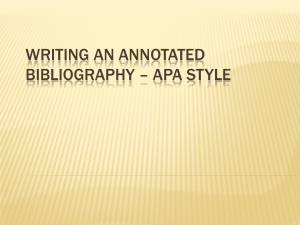

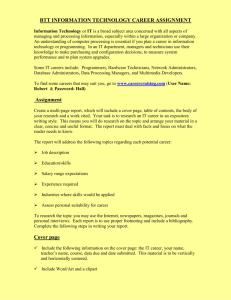
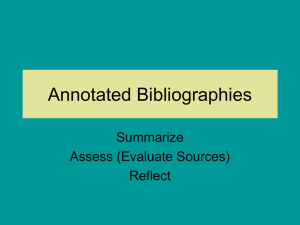
![ENC 1102 Hybrid Day 24‹Parts of an Annotated Bibliography [M 4-9]](http://s3.studylib.net/store/data/006813293_1-f9df0b3a4fca2bb83cd912cb9db27c26-300x300.png)
